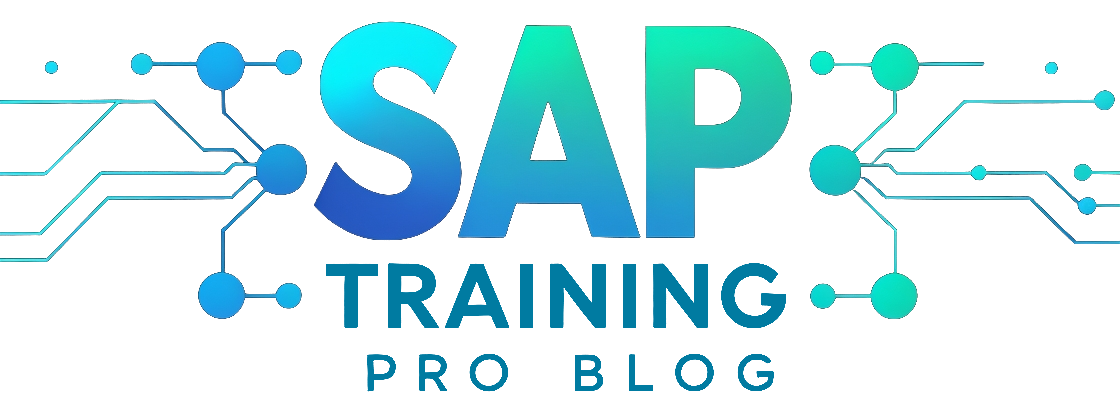SAP Modules overview: An In-Depth Overview of SAP Modules

SAP Modules overview: An In-Depth Overview of SAP Modules
Table Of Content
- Financial Accounting (FI)
- Human Capital Management (HCM)
- Employee Self-Service (ESS)
- Performance Management
- Organizational Management
- Time and Attendance Management
- Supply Chain Management (SCM)
- Materials Management (MM)
- Production Planning (PP)
- Warehouse Management (WM)
- Customer Relationship Management (CRM)
- Sales and Distribution (SD)
- Marketing
- Service
This article provides a detailed overview of the different SAP modules and their functionalities within the SAP system.
SAP, which stands for Systems, Applications, and Products in Data Processing, is a leading provider of enterprise software solutions. The SAP system consists of various modules that cater to different business functions, allowing organizations to streamline their operations and enhance productivity.
Each SAP module focuses on a specific area of business, such as finance, human resources, supply chain management, and customer relationship management. These modules work together seamlessly, enabling companies to integrate and automate their processes, resulting in improved efficiency and effectiveness.
By understanding the functionalities of each SAP module, businesses can identify the ones that align with their specific needs and leverage them to drive growth and success. Whether it’s managing financial transactions, optimizing workforce management, streamlining procurement processes, or enhancing customer interactions, SAP modules offer comprehensive solutions for various business challenges.
Below is a brief overview of some key SAP modules:
- Financial Accounting (FI): Handles financial transactions, reporting, and analysis.
- Human Capital Management (HCM): Streamlines HR processes, including recruitment, employee management, and payroll.
- Supply Chain Management (SCM): Encompasses procurement, inventory management, production planning, and logistics.
- Customer Relationship Management (CRM): Manages customer interactions, sales, marketing, and service processes.
These are just a few examples, and there are many more SAP modules available, each designed to address specific business needs. By leveraging the power of SAP modules, organizations can optimize their operations, make informed decisions, and stay ahead in today’s competitive business landscape.
Financial Accounting (FI)
Financial Accounting (FI) is a crucial module in the SAP system that empowers organizations to effectively manage their financial data. With the SAP FI module, businesses can handle financial transactions, generate accurate financial reports, and perform in-depth analysis. This module provides a comprehensive solution for managing financial accounting processes, ensuring transparency and compliance.
Within the SAP FI module, organizations can perform various functions, including general ledger accounting, accounts payable and receivable, asset accounting, and bank accounting. It enables businesses to record financial transactions, track cash flows, and maintain accurate financial records.
Moreover, the SAP FI module supports financial reporting, allowing organizations to generate balance sheets, profit and loss statements, cash flow statements, and other financial reports. These reports provide valuable insights into the financial health of the organization and aid in decision-making.
The analysis capabilities of the SAP FI module enable organizations to analyze financial data, identify trends, and make informed financial decisions. It provides tools for financial planning, budgeting, and forecasting, helping businesses optimize their financial resources.
In summary, the SAP FI module is an essential component of the SAP system that empowers organizations to manage their financial data effectively. It streamlines financial accounting processes, ensures compliance, and provides valuable insights for decision-making.
Human Capital Management (HCM)
Discover how the SAP HCM module streamlines HR processes, including recruitment, employee management, payroll, and talent management, helping businesses optimize their workforce.
The SAP HCM module is designed to simplify and automate various aspects of human resource management, allowing organizations to efficiently handle their workforce. This module encompasses a range of functionalities that cover the entire employee lifecycle, from recruitment to retirement.
One of the key features of SAP HCM is its recruitment management system, which enables organizations to streamline the hiring process by automating job postings, applicant tracking, and candidate selection. This not only saves time and effort but also ensures that the right talent is brought into the organization.
Employee management is another crucial aspect of SAP HCM. It provides tools and functionalities to manage employee data, such as personal information, job details, and performance records. This allows HR professionals to easily access and update employee information, ensuring accurate and up-to-date records.
In addition, the payroll management component of SAP HCM simplifies the payroll process by automating calculations, tax deductions, and payment processing. This helps organizations ensure accurate and timely payment to their employees, while also complying with legal and regulatory requirements.
Talent management is another area where SAP HCM excels. It provides tools for identifying and developing talent within the organization, including performance management, succession planning, and learning management. By effectively managing talent, businesses can maximize employee potential and drive organizational growth.
In conclusion, the SAP HCM module plays a crucial role in streamlining HR processes and optimizing workforce management. With its comprehensive functionalities, organizations can efficiently handle recruitment, employee management, payroll, and talent management, ultimately enhancing productivity and achieving business success.
Employee Self-Service (ESS)
Employee Self-Service (ESS) is an essential functionality within the SAP HCM module that empowers employees to take control of their personal information, time-off requests, and benefits. With ESS, employees have the convenience and flexibility to access and manage their own data, reducing the administrative burden on HR departments and promoting self-sufficiency among employees.
Through the ESS feature, employees can easily update their personal information, such as contact details and emergency contacts, ensuring that their records are always accurate and up to date. This not only saves time but also improves data accuracy and reliability within the organization.
In addition to managing personal information, ESS allows employees to submit time-off requests directly through the SAP system. Whether it’s vacation time, sick leave, or any other type of absence, employees can conveniently request time off and track the status of their requests, eliminating the need for manual paperwork and streamlining the approval process.
Furthermore, ESS provides employees with access to their benefits information, allowing them to view and manage their benefits selections, enroll in new programs, and make changes to existing plans. This empowers employees to make informed decisions about their benefits, enhancing their overall satisfaction and engagement.
Overall, the ESS functionality within the SAP HCM module revolutionizes the way employees interact with their personal information, time-off requests, and benefits. By putting control in the hands of employees, organizations can promote efficiency, accuracy, and employee satisfaction, ultimately driving productivity and success.
Performance Management
Performance management is a crucial component of the SAP HCM module, offering organizations the tools they need to set goals, track employee performance, and conduct performance appraisals. With this functionality, businesses can effectively monitor and evaluate the performance of their workforce, ensuring alignment with organizational objectives and driving continuous improvement.
One of the key features of performance management in SAP HCM is the ability to set goals. Organizations can define specific targets and objectives for employees, providing them with clear direction and focus. This enables individuals to understand what is expected of them and work towards achieving those goals.
Furthermore, the performance management component allows organizations to track employee performance on an ongoing basis. Through regular monitoring and feedback, managers can assess how well employees are performing and identify areas for improvement. This helps in recognizing top performers, providing support and development opportunities to those who need it, and ultimately driving overall productivity and success.
Performance appraisals are also a critical part of the performance management process. With SAP HCM, organizations can conduct comprehensive evaluations of employee performance, taking into account various factors such as skills, competencies, and achievements. This enables fair and objective assessments, facilitating effective performance discussions and the identification of development needs.
In summary, the performance management component of SAP HCM empowers organizations to set goals, monitor employee performance, and conduct performance appraisals. By leveraging this functionality, businesses can optimize their workforce, enhance productivity, and drive continuous improvement.
Organizational Management
Organizational Management is a crucial feature within the SAP HCM module that offers businesses the ability to define and manage their organizational structure effectively. By utilizing this feature, organizations can establish hierarchies, reporting lines, and other structural elements that are essential for efficient operations.
With Organizational Management, businesses can create and maintain a clear and comprehensive overview of their workforce. This includes defining job positions, roles, and responsibilities, as well as establishing reporting relationships between employees. By having a well-defined organizational structure, businesses can streamline decision-making processes, improve communication, and enhance overall efficiency.
In addition, Organizational Management enables businesses to analyze and visualize the organizational structure through graphical tools and reports. This provides valuable insights into the distribution of resources, identifies potential bottlenecks, and helps in making informed decisions regarding workforce planning and development.
Overall, the Organizational Management feature in SAP HCM plays a vital role in helping businesses optimize their organizational structure, ensuring smooth operations, and fostering growth and success.
Time and Attendance Management
Time and attendance management is a crucial aspect of any organization, as it allows businesses to effectively track and monitor employee working hours, attendance, and leave. With the SAP HCM module’s time and attendance management functionality, organizations can streamline these processes and ensure accurate record-keeping.
By utilizing the SAP HCM module, businesses can automate time tracking, eliminating the need for manual timesheets and reducing administrative burden. The module provides features such as clock-in and clock-out functionality, allowing employees to easily record their working hours.
In addition to tracking working hours, the SAP HCM module also enables organizations to monitor employee attendance, ensuring compliance with company policies and regulations. With real-time attendance data, businesses can identify patterns, analyze trends, and take necessary actions to address any attendance-related issues.
Furthermore, the module facilitates the management of employee leave, including vacation, sick leave, and other types of time off. Organizations can set up leave policies, track leave balances, and automate the leave approval process, ensuring smooth operations and efficient resource management.
In summary, the SAP HCM module’s time and attendance management functionality offers organizations the tools they need to effectively track employee working hours, monitor attendance, and manage leave. By automating these processes, businesses can improve efficiency, reduce errors, and ensure compliance with labor regulations.
Supply Chain Management (SCM)
Supply Chain Management (SCM) is a critical component of the SAP system that helps organizations optimize their supply chain operations. The SAP SCM module encompasses various sub-modules, each focusing on a specific aspect of the supply chain process. Let’s take a closer look at these sub-modules:
- Procurement: This sub-module allows organizations to efficiently manage their procurement processes, including sourcing, purchasing, and supplier management. It enables businesses to streamline their procurement operations and ensure timely delivery of goods and services.
- Inventory Management: With the inventory management sub-module, organizations can effectively control and track their inventory levels. It provides real-time visibility into stock levels, enables efficient stock movement, and facilitates inventory optimization.
- Production Planning: The production planning sub-module enables organizations to plan and schedule their production processes. It includes features like capacity planning, material requirements planning, and shop floor control, ensuring smooth production operations.
- Logistics: The logistics sub-module focuses on managing the transportation and distribution of goods. It helps organizations optimize their logistics processes, including transportation planning, route optimization, and warehouse management.
By utilizing the SAP SCM module, organizations can achieve better supply chain visibility, enhance operational efficiency, and improve customer satisfaction. It enables businesses to streamline their procurement, inventory, production, and logistics processes, ultimately leading to cost savings and increased profitability.
Materials Management (MM)
The Materials Management (MM) module in SAP focuses on managing procurement processes, inventory control, and vendor management, all of which are crucial for ensuring efficient supply chain operations. With the MM module, organizations can effectively handle the entire procurement cycle, from requisitioning and purchasing to receiving and payment processing.
One of the key functionalities of the MM module is procurement, which involves identifying the goods and services required by the organization, selecting suitable vendors, and negotiating contracts. The module streamlines the procurement process by automating purchase requisitions, purchase orders, and goods receipt, ensuring timely and accurate procurement activities.
In addition to procurement, the MM module also enables organizations to efficiently manage their inventory. It provides tools for inventory control, including stock valuation, material classification, and inventory optimization. With real-time visibility into inventory levels and movements, businesses can minimize stockouts, reduce carrying costs, and ensure the availability of materials when needed.
Furthermore, the MM module facilitates effective vendor management. It allows organizations to maintain vendor master data, track vendor performance, and manage contracts and agreements. By establishing strong relationships with reliable vendors, businesses can ensure the timely delivery of high-quality goods and services, ultimately contributing to smooth supply chain operations.
Production Planning (PP)
Production Planning (PP) is a crucial module in the SAP system that empowers organizations to effectively plan and control their production processes. With the SAP PP module, businesses can optimize their production operations, ensuring efficient resource utilization and timely delivery of products.
One of the key functionalities of the SAP PP module is capacity planning. This feature allows organizations to determine the production capacity required to meet customer demands. By analyzing factors such as machine availability, labor capacity, and production lead times, businesses can ensure that they have the necessary resources to fulfill orders.
Another important aspect of the SAP PP module is material requirements planning (MRP). MRP helps organizations manage their inventory levels by calculating the materials needed for production based on demand forecasts and current stock levels. This ensures that businesses have the right materials at the right time, minimizing stockouts and reducing inventory holding costs.
Additionally, the SAP PP module enables organizations to control their shop floor operations. It provides tools for managing work orders, routing, and scheduling, allowing businesses to track the progress of production activities and make real-time adjustments if needed. This helps optimize production efficiency and ensure timely completion of orders.
In conclusion, the SAP PP module plays a vital role in helping organizations plan and control their production processes. With features such as capacity planning, material requirements planning, and shop floor control, businesses can streamline their production operations, improve resource utilization, and deliver products on time.
Warehouse Management (WM)
The SAP WM module is a crucial component of the SAP system that plays a vital role in optimizing warehouse operations. By effectively managing inventory movements, storage, and picking, this module ensures accurate stock management and efficient logistics.
With the SAP WM module, businesses can streamline their warehouse processes and improve overall productivity. It provides advanced features and functionalities that enable organizations to track and control the movement of goods within their warehouses. This includes managing stock levels, organizing storage locations, and automating picking processes.
One of the key benefits of the SAP WM module is its ability to ensure accurate stock management. It allows businesses to maintain real-time visibility of their inventory, enabling them to track stock levels, monitor stock movements, and prevent stockouts or overstocks. This helps in optimizing inventory levels, reducing carrying costs, and improving order fulfillment rates.
In addition, the SAP WM module enhances logistics efficiency by streamlining the picking process. It provides tools and functionalities to optimize picking routes, allocate resources effectively, and minimize errors. This not only improves order accuracy but also reduces picking time, enabling organizations to fulfill customer orders in a timely manner.
Overall, the SAP WM module is a powerful tool that enables businesses to optimize their warehouse operations, ensuring accurate stock management and efficient logistics. By leveraging the advanced features and functionalities of this module, organizations can improve productivity, reduce costs, and enhance customer satisfaction.
Customer Relationship Management (CRM)
The Customer Relationship Management (CRM) module within SAP is a powerful tool that enables organizations to effectively manage customer interactions, sales, marketing, and service processes. By utilizing this module, businesses can enhance customer satisfaction and loyalty, ultimately driving growth and success.
With the SAP CRM module, organizations can streamline their customer interactions by centralizing customer data and providing a comprehensive view of each customer’s history, preferences, and needs. This allows businesses to personalize their interactions and deliver a superior customer experience.
In addition to managing customer interactions, the SAP CRM module also supports sales and marketing activities. It enables organizations to track leads, manage sales opportunities, and analyze sales performance. Furthermore, businesses can plan, execute, and analyze marketing campaigns, targeting the right audience and maximizing return on investment.
Moreover, the SAP CRM module includes service functionality that helps organizations manage customer service processes. It enables businesses to efficiently handle service requests, manage service contracts, and effectively track and resolve service orders. This ensures that customer issues are addressed promptly and efficiently, leading to higher customer satisfaction and loyalty.
Sales and Distribution (SD)
The Sales and Distribution (SD) module is an integral part of the SAP system that supports various sales and distribution processes within an organization. It encompasses functionalities such as order management, pricing, billing, and customer relationship management, enabling businesses to effectively manage their sales operations.
With the SAP SD module, organizations can streamline their order management process, from order creation to delivery and invoicing. This module allows businesses to efficiently handle sales orders, track order status, and manage customer inquiries and complaints. It also facilitates the integration of sales processes with other modules, such as inventory management and financial accounting.
Moreover, the SAP SD module enables organizations to define and manage pricing strategies, including discounts, promotions, and special offers. It provides robust pricing functionality that allows businesses to determine accurate prices for products and services, ensuring profitability and competitiveness.
In addition, the SD module supports billing processes, allowing businesses to generate invoices, track payment status, and manage credit limits. It provides comprehensive billing functionality that includes features such as invoice verification, credit management, and payment processing.
Furthermore, the SAP SD module plays a crucial role in customer relationship management (CRM). It helps businesses build and maintain strong relationships with customers by providing tools for managing customer interactions, sales opportunities, and service requests. With the SD module, organizations can enhance customer satisfaction and loyalty by delivering personalized and efficient sales and service experiences.
Marketing
Marketing: The marketing component of SAP CRM is a powerful tool that empowers businesses to plan, execute, and analyze their marketing campaigns with precision. By leveraging this module, organizations can target the right audience and maximize their marketing return on investment (ROI).
With SAP CRM’s marketing functionality, businesses can create comprehensive marketing campaigns that encompass various channels, such as email, social media, and online advertising. The module provides a range of features and tools that enable marketers to segment their target audience based on demographics, interests, and behaviors, ensuring that the right message reaches the right people.
Furthermore, SAP CRM allows marketers to track and measure the effectiveness of their campaigns in real-time. They can analyze key metrics, such as click-through rates, conversion rates, and customer engagement, to gain valuable insights and make data-driven decisions. This helps businesses optimize their marketing strategies and allocate their resources more effectively.
In addition to campaign planning and execution, the marketing component of SAP CRM also offers advanced analytics capabilities. Marketers can generate reports and dashboards that provide in-depth insights into campaign performance, customer behavior, and market trends. These insights enable businesses to refine their marketing strategies, identify new opportunities, and stay ahead of the competition.
Service
Service functionality within the SAP CRM module is a crucial component that helps organizations effectively manage their customer service processes. With this functionality, businesses can handle various aspects of customer service, including service requests, service contracts, and service order management.
With the service functionality, organizations can efficiently handle and track service requests from customers. This includes managing customer inquiries, complaints, and requests for assistance. By centralizing these requests within the SAP CRM module, businesses can ensure prompt and effective resolution, improving customer satisfaction.
In addition to managing service requests, the SAP CRM module’s service functionality enables organizations to handle service contracts. This involves creating and managing contracts with customers, specifying the terms and conditions of service agreements. By having a centralized system for contract management, businesses can easily track contract details, monitor service levels, and ensure compliance.
Furthermore, the service functionality within the SAP CRM module facilitates service order management. This includes creating and managing service orders, assigning resources, tracking progress, and monitoring service delivery. By streamlining these processes, organizations can optimize their service operations, ensuring timely and efficient service delivery to customers.
In summary, the service functionality within the SAP CRM module empowers organizations to effectively manage customer service processes. By handling service requests, managing service contracts, and facilitating service order management, businesses can enhance customer satisfaction, improve service efficiency, and drive customer loyalty.


